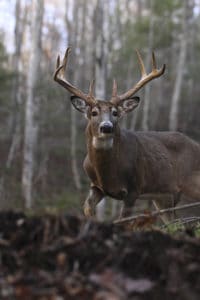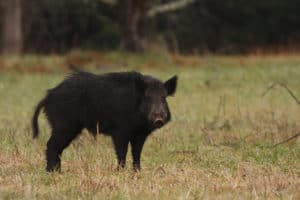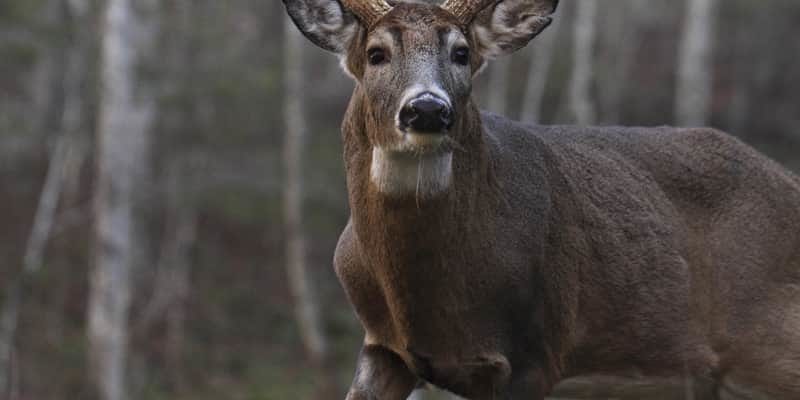By Beau Tallent
Planning a hunt is half the fun. Every hunter has dreams of taking a big trip, hunting new terrain, and possibly even tackling the challenge of pursing a new species.

To harvest a big buck, a hunter has to target areas not only where big bucks are common, but also where they are killable. The Midwest farm region is renowned for big-racked white-tailed bucks and great results for hunters.
A lineup of the most coveted American big game is complete only when trophy white-tailed deer, Rocky Mountain elk, and wild boar are included. Fortunately, a hunt for any or all of the Big Three is within relatively easy reach.
Hunters can always go the guided route for a catered trip. However, a great hunt also awaits the adventurous do-it-yourself hunter. It just takes a little research, preparation, and planning. We’ve put together information on doable hunts for big Midwest bucks, Rocky Mountain elk, and wild boar in the Deep South.
Midwest Whitetails
Deer are everywhere these days. Trophy bucks are not. The first step in killing a big buck is quite simple; you have to hunt where they are. Watch one of those all-hunting-all-the-time television stations, and it won’t be long before you’re seeing a hunt for trophy white-tailed bucks somewhere in the Midwest.
A variety of factors combine to make our “Fly-Over States” prime for producing big bucks. There’s the fertile soil and nutritious farm fields. Another significant factor for growing big bucks is old age. Midwest states have very short firearms deer seasons, so more bucks make it to older age classes.
I learned of the other reason the Midwest has the go-to states for big bucks when my Alabama hunting buddies began to desert me and our long-time lease. We had big bucks, but the big bucks on our place are tougher to kill than those farm-belt bucks of the Midwest. It’s the habitat. In the South, there are expansive tracts of woods, thickets, and swamps. In the Midwest, there are ribbons of woods that form the edges of farm fields where deer feed. Those narrow bands of woods are much easier to hunt. It’s not shooting fish in a barrel, by no means, but the giant bucks in Midwest farm territory are killable.
Technically, the Midwest region is comprised of 12 states. We will focus on two of the best for big farm-country whitetails, Illinois and Kansas. Because of their popularity with hunters, nonresidents must apply for a deer-hunting permit in these states.
In Kansas, applicants must apply in April each year at https://www.ks.wildlifelicense.com/start.php or by phone (620) 672-0728. Paper applications and mail-in forms are no longer allowed for Kansas permit applications. A Kansas nonresident white-tailed deer permit costs $346.96 if you’re 16 or older. It’s $116.34 for youth 15 and younger. The bag limit is two, only one of which can be a buck or fawn. In Kansas, a hunter applies in one unit and selects one adjacent unit in which to also hunt, as well as the season choice (archery, muzzleloader, or firearm) at the time of application. Online research on available public land and full-service outfitters will narrow your unit choice. The success rates for drawing a Kansas bowhunting deer permit are very good in most units.
A good option for the Kansas do-it-yourself hunter is Fort Riley, which lies in Deer Unit 8. To see the type of bucks harvested at Fort Riley last season and in past years, visit https://fortriley.isportsman.net/Hunting-2014-images.aspx. Just be prepared to spend some time browsing the galleries and drooling over pictures of some fantastic public-land bucks. For more information on Fort Riley deer hunting, contact the Environmental Division Office at (785) 239-6211, or visit https://fortriley.isportsman.net.
Illinois also has a lottery for deer permits. For archery deer permits, the application period is in June. To apply, visit the Illinois DNR website at www.dnr.illinois.gov. The number of nonresident archery tags was increased several years ago, making it very likely a nonresident will draw an archery tag each year. An Illinois nonresident deer archery permit is $411. To do some detailed homework, check out the harvest and hunter-effort numbers from past seasons at www.dnr.illinois.gov/hunting/Documents/IllinoisPublicHuntingAreasReport.pdf. For more information, contact the Illinois Department of Conservation at (618) 435-8138.
A public-land option in southern Illinois is the massive Shawnee National Forest, with more than 250,000 acres of terrain that varies from rugged ridges and ravines to rolling fields. While huge in terms of acres, the Shawnee isn’t one giant tract of land. It is very fragmented, with private land interspersed throughout. A savvy hunter can use the private land as an advantage. Look for isolated, hard-to-access national forest tracts that border agriculture fields. Traditional areas with trophy-buck potential are Jackson, Pope and Union counties. Alexander County is home to the Cypress Creek National Wildlife Refuge, where hunters can access remote areas by jonboat (there’s a 10 hp motor limit).
Bowhunting pressure is generally not heavy on the Shawnee National Forest, although shotgun season sees fairly heavy hunting pressure. With a little homework, you can find a less crowded hunting spot. For maps, call the U.S. Forest Service at (618) 253-7114.
Elk In The Colorado Rockies
A hunt for Rocky Mountain elk may seem like just a pipe dream for many, but I know first-hand this is one dream hunt you can make a reality. After reading about elk hunting and seeing the exciting hunting shows for years, I finally loaded up my truck and steered it west. After a night in Amarillo, the next day I was standing in camo, with bow in hand, at 6,000 feet in southwest Colorado, about to begin the best week of my hunting career.
For days, I hiked and hunted hard. Some days I ventured far from the nearest road, carrying a sleeping bag, food, and water on my back. In some areas, I found little sign that elk even lived on that mountain. Finally, on the fourth day, I found fresh tracks around a big, muddy wallow. As darkness fell, I unrolled my sleeping bag and tried to sleep. The excitement of looking up at the stars from an elevation of 7,500 feet was enough to keep me awake… if it were not for the bugling bull that bellowed constantly all night long.
Daylight couldn’t come soon enough. I simply eased through a 200-yard-wide stand of aspen to overlook a narrow, very steep meadow that would pass for a black diamond ski-run if it had snow covering it. I heard the bull again, very close, and then watched as he herded more than 20 cows into the steep meadow. While waiting for the bull, a modest 5×4, to present a shot, I heard something right in front of me and noticed movement. Five yards away, the mouth of a huge cow elk pulled at a leaf and began to chew. When she took a step, I saw a vitals area that looked as big as my truck hood, and I heart-shot her at point blank range. She fell in the meadow, and I was able to video the bull and the herd of cow elk as they stood for a moment before piling out of the steep shoot.
The Colorado archery season for elk this year is Aug. 29 through Sept. 27. A nonresident Colorado either-sex/fishing combo license is $616. If you just want elk meat—a lot of it—you can purchase the nonresident cow (female elk only) combo license for $461. A nonresident youth/fishing combo is $100.75. Also required is an annual $10 Habitat Stamp for any hunter 18 to 64 years old.
There are better trophy bull states, for sure. But this poor boy picked Colorado because archery elk hunters can get a tag over-the-counter without a quota. I hunted the Uncompahgre National Forest in southwest Colorado, but the available public land is seemingly endless. A good online researcher can narrow a search by studying elk harvest results in each Game Management Unit (GMU). There’s a wealth of info and maps on the Colorado Parks & Wildlife website at http://cpw.state.co.us. A great resource for info is the Colorado Hunting Atlas, available online at http://ndismaps.nrel.colostate.edu/huntingatlas.
Go Wild For Georgia Hogs

The allure hunters have for stalking wild hogs is matched by the disdain from landowners for this often-destructive animal. The result is liberal seasons and few regulations. At Fort Stewart in southeast Georgia, wild hogs can be hunted year-round, except during spring turkey season.
Slipping through a South Georgia swamp while closing the distance on a group grunting, snorting, nasty-tempered wild hogs may seem like an odd desire. Not if you’re a die-hard big-game hunter. Wild hogs are fun to hunt. There’s a slight (although over-exaggerated and glamorized) hint of danger, and dang if wild hogs don’t provide some of the best wild meat you’ll ever bring home.
While many hunters love to hunt wild hogs, landowners hate these destructive critters that seem to breed more successfully than rabbits. Because wild hogs aren’t native to North America, and because they can destroy habitat and impact animal and plant species, state agencies continue to liberalize hunting regulations for wild hogs. On private land in Georgia, you can hunt wild hogs year-round, over bait, with no limit. An online search will reveal lots of outfitters for guided hunts on private land.
There’s plenty of public-land opportunity for wild hogs in Georgia, and Fort Stewart ranks near the top. Fort Stewart is a huge 279,000-acre military base about an hour south of Savannah, Ga.
More than half of Fort Stewart’s acreage is open for public hunting—about 120,000 acres are kept off-limits to the public for military training. Feral pigs can be hunted year-round on Fort Stewart except during turkey season, when only bowhunters can hunt hogs and only in archery-only areas. Turkey season in Georgia is late March to May 15, so you’re talking about more than nine months of wild hog hunting at Fort Stewart. There is no bag limit, and hunters kill between 500 and 1,000 hogs a year.
There are a wide variety of habitat types on Fort Stewart. If you go for a summertime hunt, concentrate on the bottomland swamps where the pigs will seek refuge from the heat. The Ogeechee and Canoochee rivers wind through the vast wilds of Fort Stewart. There are also numerous small creeks and swamps, along with larger creeks like Taylor’s Creek. If you hunt in the fall, find hardwood flats where acorns are dropping.
There are quite a few special restrictions on hunting at Fort Stewart. For details and information on how to get a hunting permit, call (912) 435-8061 or visit the website at http://www.stewart.army.mil/info/?id=448.
The Union Sportsmen’s Alliance website is designed to provide valuable articles about hunting, fishing and conservation for members of AFL-CIO affiliated labor unions and all sportsmen and sportswomen who appreciate hunting and fishing and want to preserve our outdoor heritage for future generations. If you would like your own story and experience from the outdoors to be considered for our website, please email us at [email protected].




